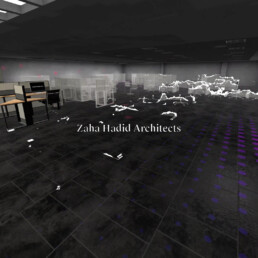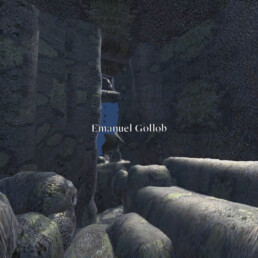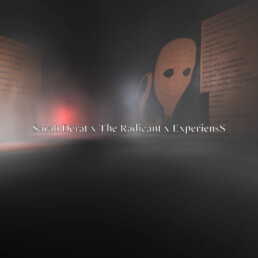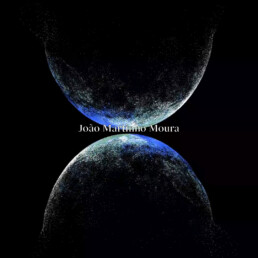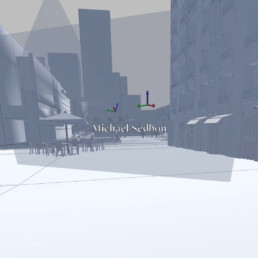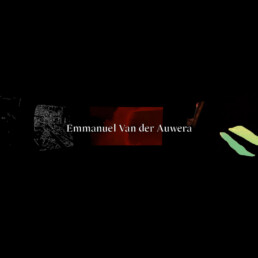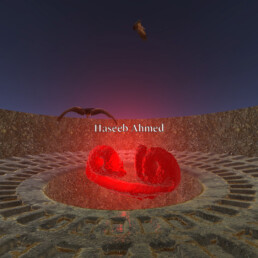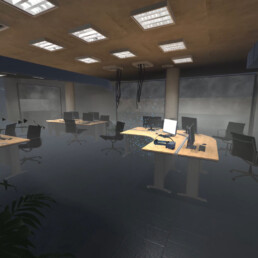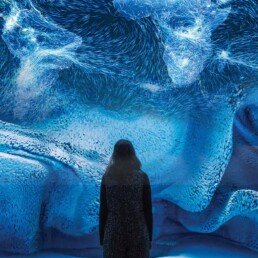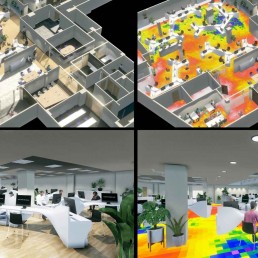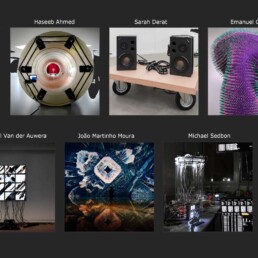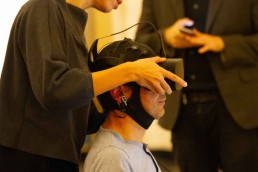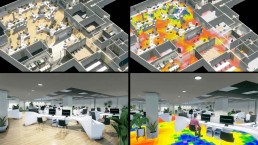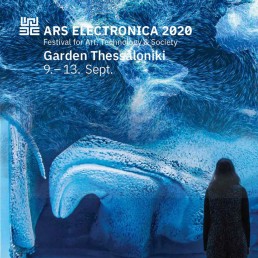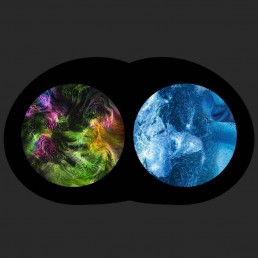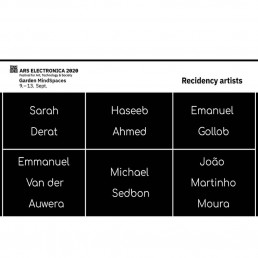SYNX 2021 - MindSpaces
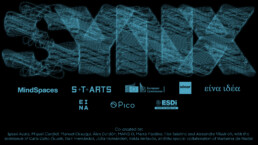
SYNX
A project by Eina Idea in collaboration with MindSpaces and Sónar CCCB
Location: CCCB / Online
Dates: 28, 29 and 30 October, 2021
Eina Idea in collaboration with MindSpaces took part in the festivals AI and Music and Sónar+D CCCB in Barcelona with a twofold project named SYNX, consisting of a VR exhibition and a symposium. The project, as a whole, looks at contemporary urban life as an unresolved choreography of sense and movement data, emphasizing the challenges of organizing collective response and individual action based on algorithmic principles. Social rhythms—kinetic, visual, aural, emotional—and accidents related to their programmability become the point of departure for a reflection on urban complexity in our immediate future. The SYNX exhibition features art, architecture, and interactive storytelling in a game-like experience.
The show presents the current research of six contemporary artists as part of the MindSpaces residency program, an initiative of S+T+ARTS and the European Commission. SYNX includes digital works by Haseeb Ahmed, Emmanuel Van der Auwera, Sarah Derat x The Radicant x ExperiensS, Emanuel Gollob, Joao Martino Moura, Michael Sedbon, with the special collaboration of Zaha Hadid Architects. The artworks and speculative designs to be presented within a VR environment have been co-designed by a Barcelona-based team of designers under the direction of Eina Idea. Students and professors from EINA University Center of Design and Art and ESDi School of Design have also collaborated in the project. At CCCB on October 28-30, 2021, full access to this experience will be offered in VR thanks to the partnership of Pico Interactive. Meanwhile, an embedded, online version of SYNX is available to visitor-players worldwide through the Sónar+D and AI and Music websites, alongside MindSpaces and Eina Idea communication channels.
Blending test models of private homes, offices, streets, crowd control, archaeological sites, and even virtual gallery spaces, artworks in the exhibition address the power of current technologies focused on obtaining experiential data from contemporary urban dwellers—users and performers of the everyday life amidst a web of connected devices. The goal of technologies explored in SYNX, and developed throughout the S+T+ARTS MindSpaces project, is the observation of interactions between built environments and their occupants, aiming at an increase in space adaptability and responsiveness. As a game-like architecture, SYNX presents these questions in a fictional setting where sensing technologies have become autonomous and operate capriciously, challenging the stability and reliability of their own data. In the haunted scenery of SYNX, a legend about technology becomes the narrative for the exhibition visit as an exercise in dystopian archaeology.
SYNX has been co-designed by Ignasi Ayats, Miquel Cardiel, Manuel Cirauqui, Alex Cordon, MANS O, Marta Pardina, Flor Salatino, and Alexandre Viladrich, with the assistance of Clara Cubo-Gasch, Dani Hernández Palomeque, Júlia Hernández González, Iraida Serlavós, and the special collaboration of Marianna de Nadal.
The virtual exhibition was accompanied by a symposium streamed live on October 29th, in which the exhibition artists and designers shared ideas with leading voices in science, urban planning, artistic research, and design fiction to discuss the topics of SYNX. Guest participants in the symposium include Elena Bartomeu, novelist and speculative design professor at EINA; Lluís Nacenta, musician, theorist, and director of HANGAR; Artur Garcia, head of quantum computing at the Barcelona Supercomputing Center; and Mel Slater, neuroscientist and virtual environments expert at the University of Barcelona. The event was conducted and moderated by Béatrice de Gelder, head of the Neuroscience Laboratory at Univerity of Maastricht, and Manuel Cirauqui, director of Eina Idea, and will include a virtual tour of the exhibition. The SYNX Talk Show was presented at the auditorium of CCCB in Barcelona and as an online broadcast via Sónar’s website.
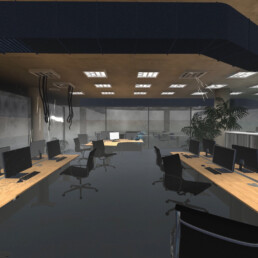
Download Links
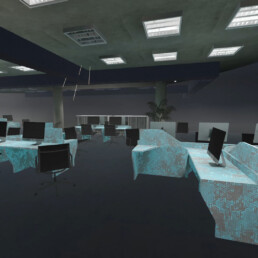




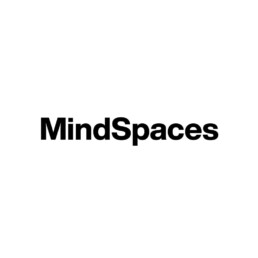
Open Call Video
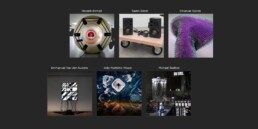
MindSpaces Resident Artists
MindSpaces (INT), University of Maastricht (MU), Eina Idea (ES)
Teaser video
MindSpaces resident artists translate and present their residency research into virtual experiences to be hosted at Sonar+D festival in October. The proposed content of the exhibition will feature MindSpaces resident artists in a virtual game-like experience. The artists’ current research is being translated into a digital environment while inscribing them in a broader discussion on urban life and emotional engagement. Through this exhibition, MindSpaces articulate some key elements of the project into a different narrative and discussion context. Artists-in-residence: Haseeb Ahmed (US), Sarah Derat (FR), Emanuel Gollob (AT), Emmanuel Van der Auwera (BE), João Martinho Moura (PT), Michael Sedbon (FR)
MindSpaces Resident Artists
Acknowledgements
MindSpaces Consortium
Centre for Research and Technology, Hellas, University of Maastricht, Pompeu Fabra University, Aristotle University of Thessaloniki, McNeel Europe SL, Up2Metric, Nurogames,Zaha Hadid Architects, Maurice Benayoun, Analog Native , Espronceda, e-Sèniors, The town of L’Hospitalet de Llobregat,The university of Hong Kong)
Artists
Maurice Benayoun
Refik Anadol
Artists in residency
Haseeb Ahmed, Sarah Derat, Emanuel Gollob, Emmanuel Van der Auwera, João Martinho Moura, Michael Sedbon
Live Discussion
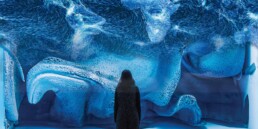
Art-Technology-Architecture
(Live Discussion)
CERTH (GR), Refik Anadol (TR/US), Maurice Benayoun (HK/FR), Tyson Hosmer (UK), Anastasios Tellios (GR), Stefanos Vrochidis (GR), Georgakopoulou Nefeli (GR)
Architecture today is a multidisciplinary knowledge platform, combining input from engineering, the humanities, and the environmental, cognitive and social sciences. Technological advancements in artificial intelligence, machine learning and physiological sensing are radically affecting the entire world of architecture and can foster and enhance the creative process of architects. By engaging architects, engineers, scientists and artists in a broad exploration of these technologies, it is time to expand the design capabilities of architects, transform the attributes of architectural and urban, physical or virtual designed environments; while respecting human needs and sensitivities and promoting a new, more inclusive agenda for human life and experience. How can the dialogue between art, science and technology lead to a design process that makes our habitat (cities and nature) more inclusive, innovative, and creative? In this session, we have invited artists, architects and researchers on AI from the STARTS H2020 MindSpaces project to present their exploration with these technologies and their creative practice at the intersection of artificial intelligence, machine learning, architecture and design. Program Keynote: AI technologies for Art & Design. The MindSpaces paradigm, Stefanos Vrochidis (GR) Senior Researcher (Grade C’) with CERTH-ITI and the Head of the Multimodal Data Fusion and Analytics Group. Speakers: Refik Anadol (TR/US), media artist, director, and pioneer in the aesthetics of machine intelligence; Maurice Benayoun (HK/FR), French pioneer, contemporary new-media artist, curator and theorist, based in Paris and Hong Kong; Tyson Hosmer (UK), Associate Researcher at Zaha Hadid Architects, leading grant-funded research development of cognitive agent-based technologies and machine learning for generative design; Anastasios Tellios (GR), Professor of Architectural Design: Theory and Practice at the School of Architecture, AUTH. Moderator: Nefeli Georgakopoulou (GR), Senior Research Associate with CERTH-ITI, architect and media artist.
Live Stream (Swapcard and Youtube)
Thursday, September 9, 2021 1:30 PM to 3:00 PM CET

Refik Anadol
Refik Anadol (TR/US) is a media artist, director, and pioneer in the aesthetics of machine intelligence. His body of work locates creativity at the intersection of humans and machines. In taking the data that flows around us as his primary material and the neural network of a computerized mind as his collaborator, Anadol paints with a thinking brush, offering us radical visualizations of our digitized memories and expanding the possibilities of architecture, narrative, and the body in motion. Anadol’s site-specific parametric data sculptures, live audio/visual performances, and immersive installations take many forms, while encouraging us to rethink our engagement with the physical world, its temporal and spatial dimensions, and the creative potential of machines.
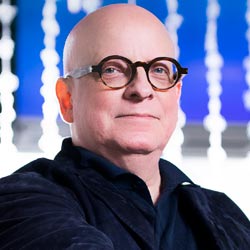
Maurice Benayoun
Maurice Benayoun (HK/FR): (aka MoBen or 莫奔,born 29 March 1957 in Mascara, Algeria) is a French pioneer, contemporary new-media artist, curator and theorist based in Paris and Hong Kong. His work employs various media, including (and often combining) video, computer graphics, immersive virtual reality, the Internet, performance, EEG, 3D printing, large-scale urban media art installations and interactive exhibitions. Often conceptual, Maurice Benayoun’s work constitutes a critical investigation of the mutations in contemporary society induced by emerging or recently adopted technologies.
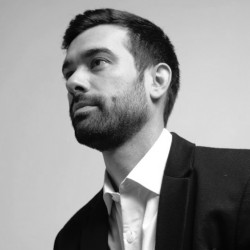
Tyson Hosmer
Tyson Hosmer (UK): is an architect, researcher, and software developer working as an Associate Researcher at Zaha Hadid Architects, leading grant-funded research development of cognitive agent-based technologies and machine learning for generative design. He is a Lecturer at UCL Bartlett BPro in London, where he directs the Living Architecture Lab (RC3), focusing on autonomously reconfigurable architecture and winning the Autodesk Emerging Research Award at Acadia 2019 for his co-authored paper, Towards an Autonomous Architecture. His 13 years of experience in practice includes working with Asymptote Architecture, Kokkugia, AXI:OME, and serving as Research Director for the Cecil Balmond Studio for six years.
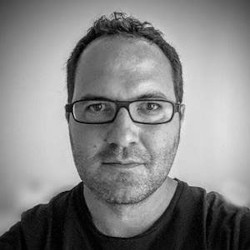
Anastasios Tellios
Anastasios Tellios (GR): is a Professor of Architectural Design: Theory and Practice at School of Architecture, AUTh. He is the Director of the Department of Architecture and Urban Design, Director of the Postgraduate Program ‘Advanced Design: Innovation and Transdisciplinarity in Design’, and Director of the Research Unit ‘INNEN Innovative Environments’. He is participating in projects, research programs and international architectural events in the areas of architectural and urban design. His academic interests are related to advanced architectural design, spatial experimentation, design theories, research by design and emerging technologies. He is lecturing in Greece and internationally. His work theoretical and practical, as architect and educator, has been published and exhibited in Greece and abroad.
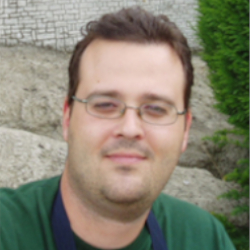
Stefanos Vrochidis
Stefanos Vrochidis (GR): is a Senior Researcher (Grade C’) with CERTH-ITI and the Head of the Multimodal Data Fusion and Analytics Group. His research interests include multimodal fusion, computer vision, artificial intelligence for e-Health, environmental, media/arts, industrial and security applications. Dr. Vrochidis has participated in more than 50 research projects and been the coordinator for several projects relevant to media, arts and design (H2020 MindSpaces, H2020 V4Design, etc). He is the co-author of three books, 39 refereed journals, 175 conferences and 15 book chapter articles.
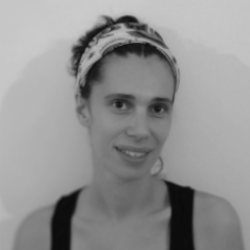
Georgakopoulou Nefeli
Georgakopoulou Nefeli (GR): is a Senior Research Associate with CERTH-ITI. After completing her master’s degree in Digital Arts and Virtual Reality from the Paris 8 University and the Athens School of Fine Arts (2014), she became a member of the EnsadLab research laboratory at the École nationale supérieure des Arts Décoratifs in Paris (2014-2017). She is currently conducting her PhD at Paris 8 University -INREV. She has participated in several EC-funded ICT projects, and her research interests include human-machine interaction, mixed reality, robotic art, digital aesthetics and the use of AI in an artistic context.
Garden Thessaloniki
Thessaloniki Garden will host MindSpaces project, funded by the European HORIZON2020-STARTS program. To encourage collaboration of research projects and artists, STARTS funded STARTS residencies of artists in technology institutions and of scientists and technologists in studio of artists.
People experience the built environment differently according to their social, cultural and economic background. The variety of this experience requires consideration, if we want all users to feel that a particular space or place belongs to them. Towards this direction, MindSpaces seeks to transform the practice of architecture by integrating the full diversity of how people experience and behave in the spaces we design by using innovative artistic-driven digital technologies. With the use of Virtual Reality, biosensors, artificial intelligence algorithms and simulations, design decisions may be taken in relation to a detailed understanding of the users preferences and collective behaviour.
Acknowledgements
MindSpaces Consortium
Centre for Research and Technology, Hellas, University of Maastricht, Pompeu Fabra University, Aristotle University of Thessaloniki, McNeel Europe SL, Up2Metric, Nurogames,Zaha Hadid Architects, Maurice Benayoun, Analog Native , Espronceda, e-Sèniors, The town of L’Hospitalet de Llobregat,The university of Hong Kong)
Artists
Maurice Benayoun
Refik Anadol
Artists in residency
Haseeb Ahmed, Sarah Derat, Emanuel Gollob, Emmanuel Van der Auwera, João Martinho Moura, Michael Sedbon
Workplaces.AI
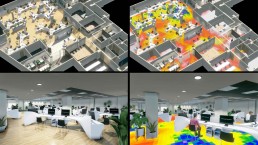
Workplaces.ai
Zaha Hadid Architects (UK) Tyson Hosmer (UK)
Mindspaces – Inspiring Workplaces
An interactive application called Workplaces.ai has been developed by Zaha Hadid Architects’ ZH-Social Research Group as part of the Mindspaces STARTS project. The team focuses on the development of a new methodology for the comparative appraisal of the social functionality of design options, by investigating the social interaction processes to be expected in architectural environments via agent-based simulations with differentiated agent populations and autonomous decision processes. Through this process, it studies the relationship between human life process behaviour in relation to architecture to actively measure and predict social behaviour in the spaces we design. The research focuses on designing workspaces with high social performance, while expanding to investigate social interaction processes in virtual environments and events. The group aims to understand how features in built environments communicate with users and influence their collective behaviour, enabling the design of architecture with high social performance. The research involves three main components developed in parallel: 1) an agent-based computational framework for simulating and analysing the behaviour of social crowds in relation to architectural space planning. People are modelled as cognitive agents with individual internal and external state parameters, perception, and an autonomous decision-making framework to act within designed architectural environments while generating collective occupancy data; 2) a generative design model for workplace space planning, using machine learning to generate high performance layouts negotiating between a series of social and spatial performance criteria analysed through simulations; 3) an immersive experiential simulator enables users to experience and interact with designed virtual environments, while studying their behaviour in relation to them. The Workplaces.ai interactive app allows a user to enter two modes. The first enables the user to generate workplace design options by adjusting parameters which drive the model’s decisions. The second allows the user to immersively enter the virtual model, navigate and interact with it, while the social simulation runs with autonomous agents interacting within the virtual workplace environment. A series of data maps can be visualized describing the collective behaviour of the agent-based simulation in relation to the design. The program includes a menu system with options and instructions for how the user can interact with the application.
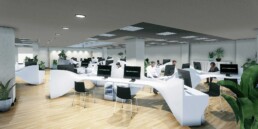
Credits
Patrik Schumacher – Chief Researcher Tyson Hosmer – Team Leader Team: Ziming He Soungmin Yu Sobitha Ravichandran Baris Erdincer
Acknowledgements
MindSpaces Consortium
Centre for Research and Technology, Hellas, University of Maastricht, Pompeu Fabra University, Aristotle University of Thessaloniki, McNeel Europe SL, Up2Metric, Nurogames,Zaha Hadid Architects, Maurice Benayoun, Analog Native , Espronceda, e-Sèniors, The town of L’Hospitalet de Llobregat,The university of Hong Kong)
Artists
Maurice Benayoun
Refik Anadol
Artists in residency
Haseeb Ahmed, Sarah Derat, Emanuel Gollob, Emmanuel Van der Auwera, João Martinho Moura, Michael Sedbon
Ars Electronica 2021
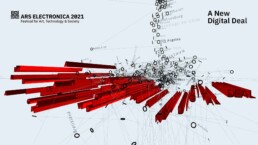
Ars Electronica 2021 Garden Thessaloniki
MindSpaces Garden

Acknowledgements
MindSpaces Consortium
Centre for Research and Technology, Hellas, University of Maastricht, Pompeu Fabra University, Aristotle University of Thessaloniki, McNeel Europe SL, Up2Metric, Nurogames,Zaha Hadid Architects, Maurice Benayoun, Analog Native , Espronceda, e-Sèniors, The town of L’Hospitalet de Llobregat,The university of Hong Kong)
Artists
Maurice Benayoun
Refik Anadol
Artists in residency
Haseeb Ahmed, Sarah Derat, Emanuel Gollob, Emmanuel Van der Auwera, João Martinho Moura, Michael Sedbon
MindSpaces residency artists

MindSpaces residency artists
Haseeb Ahmed (US), Sarah Derat (FR), Emanuel Gollob (AT), Emmanuel Van der Auwera (BE), João Martinho Moura (PT), Michael Sedbon (FR)
These interviews will discuss the work of the artists throughout their MindSpaces residency. They will present their work so far and their collaboration with the technical partners of the MindSpaces consortium. Their innovative ideas will be introduced by their art practice, through their ability to imagine futures that go beyond the current consensus in logic and engineering, setting in motion new ways of seeing, hearing, touching, feeling, transforming and experiencing spaces, places and community.
MindSpaces platform
MindSpaces platform
MindSpaces Consortium
The MindSpaces platform, encompassing the technologies of the project, will be demonstrated, showing how to design solutions for both indoor and outdoor environments using data from emotional, behavioral and discourse analysis.
Then MindSpaces platform proceeds in real-time through assessment of users’ emotional responses via wearable EEG (Electroencephalography), capturing the neuro-feedback of a VR experience of the space which will adapt accordingly.

DïaloG
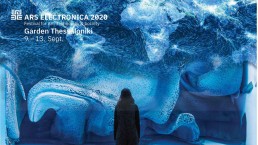
DïaloG
Refik Anadol (TR) and Maurice Benayoun (FR)
Wed Sep 9, 2020, 10:15 am – 11:00 am (UTC +2)
Where: Livestream & Ars Electronica Voyages Channel
Language: In English language
DïaloG is an urban media art installation developed (in the framework of MindSpaces Starts Horizon2020 collaborative research) by Maurice Benayoun (MoBen/CityU HK) and Refik Anadol (AnalogNative).
| Wed, 09.09.2020, 09:00 – 21:00 (CET | UTC +2) | Livestream on partner channel |
| Wed, 09.09.2020, 10:15 – 11:25 (CET | UTC +2) | on Ars Electronica Channel 3 (Gardens) |
In the public space (L’Hospitalet de Llobregat, Spain) two “living” entities face each other. They don’t look like the living beings we know. They don’t speak any language we know. They are aliens, strangers, immigrants. Facing each other they gradually mutate. They seem to react to their environment. Even more, it is clear that they are desperately trying to understand each other. In the context of social diversity of L’Hospitalet, the second city of Catalunya, a popular suburb of Barcelona, DïaloG reflects on the difficulty of building a mutual understanding beyond social and cultural differences. The real-time generated creatures have behaviors and appearance affected through AI based on their cultural background, their environment and what they perceive from the “locals” that interfere with their attempt to communicate, to understand each other.
For MindSpaces Kepler’s garden, we’ll connect online, both DïaloG living entities and observe them growing before this “encounter of the 4th kind,” when they will be facing each other. From Refik Anadol’s studio in Los Angeles, and Maurice Benayoun’s Neuro Design Lab in CityU Hong Kong we’ll see them growing, moving, and expressing their condition and their desires. DïaloG uses technologies developed by MindSpaces partners to allow a large spectrum of perceptive features that, combined with R. Anadol and M. Benayoun graphic generators and AI algorithms, create this empathic disalienation.
DïaloG Livestream

DïaloG Livestream
Refik Anadol (TR) and Maurice Benayoun (FR)
Wed Sep 9, 2020, 9:00 am – 9:00 pm (UTC +2)
Where: Livestream
Language: In English language
DïaloG is an urban media art installation developed (in the framework of MindSpaces Starts Horizon2020 collaborative research) by Maurice Benayoun (MoBen/CityU HK) and Refik Anadol (AnalogNative).
| Wed, 09.09.2020, 09:00 – 21:00 (CET | UTC +2) | Livestream on partner channel |
| Wed, 09.09.2020, 10:15 – 11:25 (CET | UTC +2) | on Ars Electronica Channel 3 (Gardens) |
In the public space (L’Hospitalet de Llobregat, Spain) two “living” entities face each other. They don’t look like the living beings we know. They don’t speak any language we know. They are aliens, strangers, immigrants. Facing each other they gradually mutate. They seem to react to their environment. Even more, it is clear that they are desperately trying to understand each other. In the context of social diversity of L’Hospitalet, the second city of Catalunya, a popular suburb of Barcelona, DïaloG reflects on the difficulty of building a mutual understanding beyond social and cultural differences. The real-time generated creatures have behaviors and appearance affected through AI based on their cultural background, their environment and what they perceive from the “locals” that interfere with their attempt to communicate, to understand each other.
For MindSpaces Kepler’s garden, we’ll connect online, both DïaloG living entities and observe them growing before this “encounter of the 4th kind,” when they will be facing each other. From Refik Anadol’s studio in Los Angeles, and Maurice Benayoun’s Neuro Design Lab in CityU Hong Kong we’ll see them growing, moving, and expressing their condition and their desires. DïaloG uses technologies developed by MindSpaces partners to allow a large spectrum of perceptive features that, combined with R. Anadol and M. Benayoun graphic generators and AI algorithms, create this empathic disalienation.
Ars Electronica 2020

MindSpaces - Ars Electronica 2020
Ars Electronica is one of the biggest new media art festivals in the world. Due to the pandemic, this year’s Ars Electronica Festival will be held virtually and in a hybrid model. MindSpaces will be part of Ars Electronica Festival of 2020 with activities related to its technologies, digital artists and artists in residency.
Garden Thessaloniki
MindSpaces Garden will host MindSpaces project, funded by the European HORIZON2020-STARTS program. To encourage collaboration of research projects and artists, STARTS funded STARTS residencies of artists in technology institutions and of scientists and technologists in studio of artists.
The design of space, on architectural and urban scales has been shown to significantly affect the emotional, cognitive wellbeing of individuals, and to influence the functionality and effectiveness of indoors and outdoors spaces in manners that have often been overlooked in the past. MindSpaces proposes a new model of real-time participation of the public in the architectural design processes. MindSpaces is a multidisciplinary initiative that integrates the arts, neuroscience, natural language technologies, architecture, 3D modelling, visual and textual fields, electroencephalography, physiological detection analysis, and augmented and virtual reality.
MindSpaces Garden will host pre-recorded interviews of the 5 artists selected from the Open Calls, a pre-recorded demonstration of MindSpaces platform and a live demonstration of the Dïalog project held by the consortiums digital artists Maurice Benayoun and Refik Anadol.
Garden Thessaloniki
MindSpaces Garden will host MindSpaces project, funded by the European HORIZON2020-STARTS program. To encourage collaboration of research projects and artists, STARTS funded STARTS residencies of artists in technology institutions and of scientists and technologists in studio of artists.
The design of space, on architectural and urban scales has been shown to significantly affect the emotional, cognitive wellbeing of individuals, and to influence the functionality and effectiveness of indoors and outdoors spaces in manners that have often been overlooked in the past. MindSpaces proposes a new model of real-time participation of the public in the architectural design processes. MindSpaces is a multidisciplinary initiative that integrates the arts, neuroscience, natural language technologies, architecture, 3D modelling, visual and textual fields, electroencephalography, physiological detection analysis, and augmented and virtual reality.
MindSpaces Garden will host pre-recorded interviews of the 5 artists selected from the Open Calls, a pre-recorded demonstration of MindSpaces platform and a live demonstration of the Dïalog project held by the consortiums digital artists Maurice Benayoun and Refik Anadol.
DïaloG Livestream
Refik Anadol (TUR) and Maurice Benayoun (FR)
Dïalog is an urban media art installation developed by Maurice Benayoun (MoBen/City UHK) and Refik Anadol (AnalogNative). In the public spaces (L’Hospitalet de Llobregat, Spain) two “living” entities face each other. They don’t look like the living beings we know. They don’t speak any language we know. They are aliens, strangers, immigrants. Facing each other they gradually mutate.
DïaloG
A Dialogue about DïaloG
Refik Anadol (TUR) and Maurice Benayoun (FR)
Dïalog is an urban media art installation developed by Maurice Benayoun (MoBen/City UHK) and Refik Anadol (AnalogNative). In the public spaces (L’Hospitalet de Llobregat, Spain) two “living” entities face each other. They don’t look like the living beings we know. They don’t speak any language we know. They are aliens, strangers, immigrants. Facing each other they gradually mutate.
MindSpaces residency artists
Haseeb Ahmed (US), Sarah Derat (FR), Emanuel Gollob (AT), Emmanuel Van der Auwera (BE), João Martinho Moura (PT), Michael Sedbon (FR)
These interviews will discuss the work of the artists throughout their MindSpaces residency. They will present their work so far and their collaboration with the technical partners of the MindSpaces consortium.
Abstract
MindSpaces project tries to improve the designing process of indoor and outdoor environments through participatory design involving and integrating multisensory measurements of individuals’ responses. Artists and architects provide ideas, after which MindSpaces’ researchers will monitor participants while they experience them. The emotional aspects of the environment will be obtained through the use of electroencephalography (EEG) and other physiological sensors that will be incorporated in a virtual reality experience. Then, the virtual space will adjust according to the neuroresponse of each individual, which will result in the creation of a space tailored emotionally to the user.

Acknowledgements
MindSpaces Consortium
Centre for Research and Technology, Hellas, University of Maastricht, Pompeu Fabra University, Aristotle University of Thessaloniki, McNeel Europe SL, Up2Metric, Nurogames,Zaha Hadid Architects, Maurice Benayoun, Analog Native , Espronceda, e-Sèniors, The town of L’Hospitalet de Llobregat,The university of Hong Kong)
Artists
Maurice Benayoun
Refik Anadol
Artists in residency
Haseeb Ahmed, Sarah Derat, Emanuel Gollob, Emmanuel Van der Auwera, João Martinho Moura, Michael Sedbon

